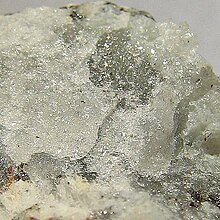
Mariposa County is a county located in the U.S. state of California. As of the 2020 U.S. Census, the population was 17,131. The county seat is Mariposa. It is located in the western foothills of the Sierra Nevada mountains, north of Fresno, east of Merced, and southeast of Stockton.

Mariposa is an unincorporated community and census-designated place (CDP) in and the county seat of Mariposa County, California, United States. The population was 1,526 at the 2020 census. The community is named after the flocks of monarch butterflies seen overwintering there by early explorers.
Alforsite is a barium phosphate chloride mineral with formula: Ba5(PO4)3Cl. It was discovered in 1981, and named to honor geologist John T. Alfors (1930–2005) of the California Geological Survey for his work in the area where it was discovered.

Pyrophyllite is a phyllosilicate mineral composed of aluminium silicate hydroxide: Al2Si4O10(OH)2. It occurs in two forms (habits): crystalline folia and compact masses; distinct crystals are not known.

Benitoite is a rare blue barium titanium cyclosilicate mineral, found in hydrothermally altered serpentinite. It forms in low temperature, high pressure environments typical of subduction zones at convergent plate boundaries. Benitoite fluoresces under short wave ultraviolet light, appearing bright blue to bluish white in color. The more rarely seen clear to white benitoite crystals fluoresce red under long-wave UV light.

The California State Mining and Mineral Museum is a museum of the state park system of California, United States. The museum exhibits and interprets the state's mineral resources and mining heritage. It is located in Mariposa, a city in central California, on the Mariposa County fairgrounds.
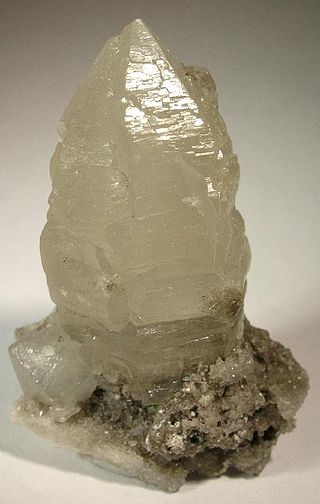
Witherite is a barium carbonate mineral, BaCO3, in the aragonite group. Witherite crystallizes in the orthorhombic system and virtually always is twinned. The mineral is colorless, milky-white, grey, pale-yellow, green, to pale-brown. The specific gravity is 4.3, which is high for a translucent mineral. It fluoresces light blue under both long- and short-wave UV light, and is phosphorescent under short-wave UV light.

Tusionite is a rare colorless to transparent to translucent yellow brown trigonal borate mineral with chemical formula: MnSn(BO3)2. The mineral is composed of 18.86% manganese, 40.76% tin, 7.42% boron, and 32.96% oxygen. It is a late stage hydrothermal mineral and occurs rarely in granite pegmatites in miarolitic cavities.
Haggertyite is a rare barium, iron, magnesium, titanate mineral: Ba(Fe2+6Ti5Mg)O19 first described in 1996 from the Crater of Diamonds State Park near Murfreesboro in Pike County, Arkansas. The microscopic metallic mineral crystallizes in the hexagonal system and forms tiny hexagonal plates associated with richterite and serpentinitized olivine of mafic xenoliths in the lamproite host rock. It is an iron(II) rich member of the magnetoplumbite group. It is a light grey opaque mineral with calculated Mohs hardness of 5.
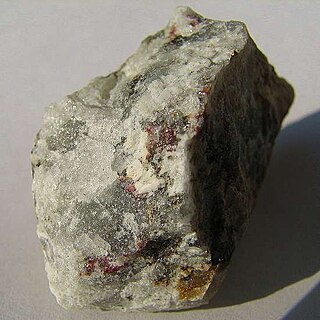
Celsian is an uncommon feldspar mineral, barium aluminosilicate, BaAl2Si2O8. The mineral occurs in contact metamorphic rocks with significant barium content. Its crystal system is monoclinic, and it is white, yellow, or transparent in appearance. In pure form, it is transparent. Synthetic barium aluminosilicate is used as a ceramic in dental fillings and other applications.
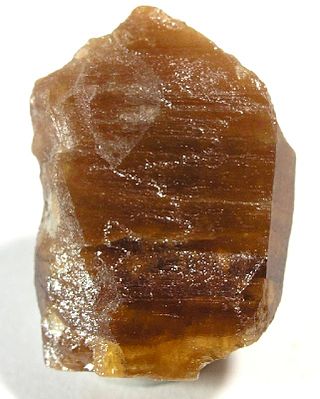
Parisite is a rare mineral consisting of cerium, lanthanum and calcium fluoro-carbonate, Ca(Ce,La)2(CO3)3F2. Parisite is mostly parisite-(Ce), but when neodymium is present in the structure the mineral becomes parisite-(Nd).
California's 5th congressional district is a U.S. congressional district in California.
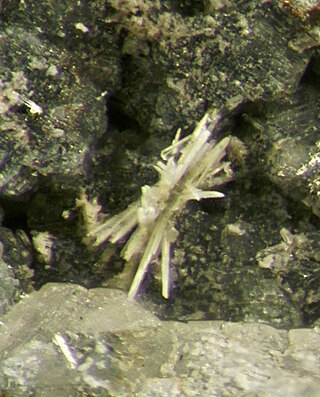
Kukharenkoite-(Ce) is a barium cerium fluoride carbonate mineral, formula Ba2CeF(CO3)3. It was identified from samples found in the Mont-Saint-Hilaire alkaline intrusive complex, Quebec, and the Khibiny Massif, Kola peninsula, Russia. It was named for Russian mineralogist Alexander A. Kukharenko (1914–1993).
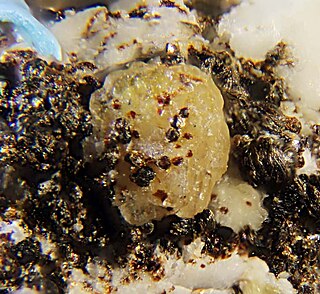
Mckelveyite-(Y) is a hydrated sodium, barium, yttrium, and uranium–containing carbonate mineral, with the chemical formula Ba3Na(Ca,U)Y(CO3)6·3H2O.
Anandite is a rare phyllosilicate with formula (Ba,K)(Fe2+,Mg)3(Si,Al,Fe)4O10(S,OH)2. It crystallizes in the monoclinic crystal system. It is black in color with a glassy luster and a near perfect cleavage.

Kampfite is a rare barium silicate–carbonate–halide mineral with the chemical formula Ba12(Si11Al5)O31(CO3)8Cl5. Discovered in 1964 and described in 2001, it is named after Anthony R. Kampf. The mineral is known only from Fresno County, California.
Frankdicksonite is a halide mineral with the chemical formula BaF2 which corresponds to the chemical compound barium fluoride. It occurs in the Carlin gold deposit of Eureka County, Nevada as cubic crystals sized between 0.1 and 4 mm, and is of hydrothermal origin. Its only associated mineral is quartz and the frankdicksonite crystals are always completely encapsulated in it. Frankdicksonite has fluorite crystal structure with a cubic symmetry and the lattice constant a = 619.64 pm. Its Vickers hardness on the {111} cleavage crystal faces varies between 88 and 94 kg/mm2 and is close to that of the synthetic barium fluoride (95 kg/mm2). Its refractive index (1.475) is almost identical to that of BaF2 (1.474). Under electron irradiation, it emits strong blue cathodoluminescence. The major impurity in frankdicksonite is strontium with concentrations up to 0.5% by weight. Also present are silicon (0.02%) and magnesium (0.0015%); other impurities have concentrations below 0.0015%.

Macdonaldite is a rare barium silicate mineral with a chemical formula of BaCa4Si16O36(OH)2·10H2O. Macdonaldite was first described in 1965 and named for Gordon A. Macdonald (1911–1978) an American volcanologist at the University of Hawaii.

Uranocircite or Uranocircite-II is a uranium mineral with the chemical formula: Ba(UO2)2(PO4)2·10H2O. Uranocircite-I was discredited (the IMA-CMNMC published 'The New IMA List of Minerals', September 2012). It is a phosphate mineral which contains barium and is a green to yellow colour. It has a Mohs hardness of about 2.
Faizievite is a very rare mineral with the formula K2Na(Ca6Na)Ti4Li6Si24O66F2. This triclinic mineral is chemically related to baratovite and katayamalite. Faizievite is a single-locality mineral, coming from the moraine of the Darai-Pioz glacier, Tien Shan Mountains, Tajikistan. Alkaline rocks of this site are famous for containing numerous rare minerals, often enriched in boron, caesium, lithium, titanium, rare earth elements, barium, and others.
